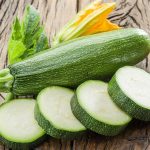 What North Americans call a zucchini, the British call a courgette. Although they derive from different languages, these two words are alike in so far as they are both diminutives of words meaning gourd: the Italian zucco and the French courge. Zucchini, however, is not only a diminutive but also a plural form: accordingly, if you are purchasing just one of these vegetables you should—in order to be precise, pedantic, and puzzling all at once—refer to it as a zucchino. The words zucchini and courgette appeared in English in the late 1920s when the vegetable was introduced to British and North American markets.
What North Americans call a zucchini, the British call a courgette. Although they derive from different languages, these two words are alike in so far as they are both diminutives of words meaning gourd: the Italian zucco and the French courge. Zucchini, however, is not only a diminutive but also a plural form: accordingly, if you are purchasing just one of these vegetables you should—in order to be precise, pedantic, and puzzling all at once—refer to it as a zucchino. The words zucchini and courgette appeared in English in the late 1920s when the vegetable was introduced to British and North American markets.
The given text refers to a type of summer squash that displays a dark-green color and bears a resemblance to a cucumber in terms of both its shape and size. Typically, this squash is not peeled prior to cooking unless it is very old and rough. It can be prepared using various methods, including sautéing, creaming, and stewing. Additionally, this type of squash is known as Italian squash.
These elongated green summer squashes encompass a diverse variety. Typically prepared with their vibrant skins intact, they can be enjoyed either whole or sliced into rounds. They lend themselves well to a range of cooking methods, such as gentle boiling in minimal water for approximately 10 to 15 minutes, steaming, sautéing, or frying. Served alongside a generous drizzle of melted butter and a sprinkling of chopped parsley or tarragon, they captivate the palate. Alternatively, one may opt to cook them, dress them with a tangy French dressing while still warm, and allow them to cool, transforming into a refreshing salad. Zucchini assumes a pivotal role in the beloved dish of ratatouille, and its versatility extends to being a valuable addition in casseroles, soups, and stews.
